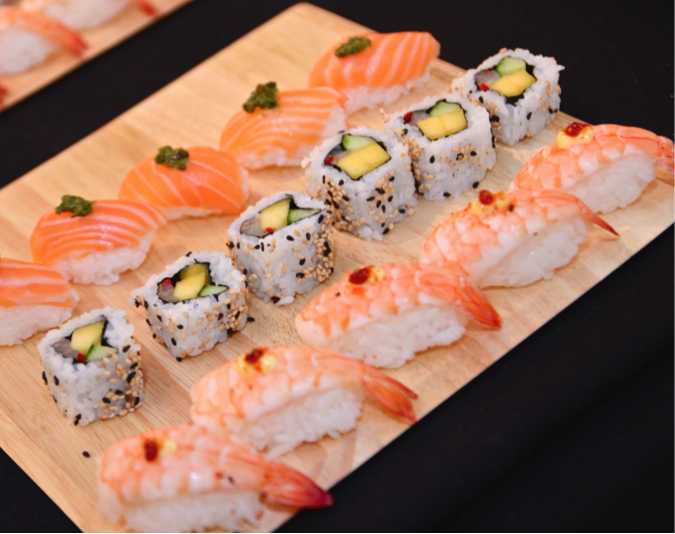
by Thomas Johnson
Over recent years, the Japanese fast food, sushi, has become so popular in the west that outlets serving up this versatile foodstuff seem almost omnipresent on our bustling high streets.
However, although a lunchtime favourite, the health conscious among are still keen to know whether sushi can offer more than just a tasty meal. Are we able to tantalise our taste buds and simultaneously shed a few pounds, or does all this sound too good to be true?
Well the fact that boffins now believe sushi to be one of the key reasons why the Japanese population are so healthy can only be a good thing. And with Japanese women boasting one of the highest life expectancies in the world, it’s no wonder why we’re chowing down so much sushi that we’ve rapidly created a multi-billion dollar industry.
However, although we’ve also managed to successfully westernise sushi to the point where it resembles little of the traditional dish, it’s therefore important to be educated on its health-bearing properties.
And who knows, maybe even encourage you to rustle up some of your own healthy sushi at home.
Fresh Fish
Raw fish is an influential component of the Japanese diet, and is a key ingredient in most types of sushi.
 As well as playing a crucial role in brain function and development, fresh fish is also packed to the brim with omega-3 polyunsaturated fats (the good kind).
As well as playing a crucial role in brain function and development, fresh fish is also packed to the brim with omega-3 polyunsaturated fats (the good kind).
As a result, the rate of heart disease among the Japanese population is astonishingly low.
With heart disease accounting for more than 25 per cent of the annual deaths here in the UK alone, sushi dishes could potentially offer so much more than a mere meal.
Seaweed
The Japanese have been munching on sea vegetables for centuries, consistently delivering them an unrivalled amount of health benefits in the process. The seaweed, or Nori, used in rolled sushi can be significantly healthier than a boring green salad found here in the west due to the level of protein, fibre, vitamins and minerals found within it.
Iodine – vital for healthy thyroid functioning, copper – influential in metabolic processes, calcium – key to healthy bones and teeth and magnesium – a key blood pressure regulator are all trace elements that can be found in abundance in seaweed.
In fact gram for gram, the amount of nutrients packed into Nori puts every plant and vegetables grown on land to shame.
Wasabi
This is that unidentifiable hot green paste, and if you’re inclined to give your health system a boost, you should probably give wasabi a try.
Thought to cleanse the palette after a meal, wasabi also produces active antimicrobial effects, a useful consequence considering the bacteria likely to be lingering within raw fish.
In addition to this, scientists in Japan have now identified key anti-inflammatory as well as anti-cancerous effects within wasabi when eaten regularly, enabling you to simultaneously fight off toxins whilst tucking into a temaki.
Ginger
 Served in pickled form and used to cleanse the palette after each piece of sushi, ginger is known to contain an oily compound, aptly named gingerols, that stimulate digestive juices and neutralise stomach acid – an obvious convenience when ingesting raw fish.
Served in pickled form and used to cleanse the palette after each piece of sushi, ginger is known to contain an oily compound, aptly named gingerols, that stimulate digestive juices and neutralise stomach acid – an obvious convenience when ingesting raw fish.
In addition, ginger is pretty good at lowering cholesterol levels and preventing blood clots producing an effect similar to aspirin, so definitely not an ingredient to be sneering at.
Brown Rice
Many sushi restaurants are making the transition from white to brown rice and for good reason!
Not only does brown rice retain much of the nutrients lost while processing white rice, including vitamins B1 & B3, iron and magnesium, but the exterior husk found on a brown rice grain is a key source of fibre that significantly reduces your cholesterol levels.
In addition, as this elevated level of fibre is harder for your body to break down, it means it has a lower glycemic index. It therefore stabilizes blood glucose levels and reduces your chance of developing type 2 diaebetes.
Sushi Sensibility Tips
Although the ingredients here look like a shopping list written by the British heart foundation, don’t be fooled into thinking that every time you head out for sushi you’re doing your body a favour.
Westernisation of the Japanese cuisine has completely transformed the traditional low fat, high mineral sushi into a tempura fried, mayonnaise filled heart attack on a plate. For this reason it’s important to revise the top tips on how to make your sushi healthier.
- Skip the Soy – it’s like dipping your sushi into liquid salt. Too much salt means high blood pressure, and high blood pressure means an increased risk of health problems such as heart disease and stroke.
- Choose Brown Rice – White rice is essentially brown rice minus the nutritional stuff! Choose brown and boost your fibre and protein intake.
- Limit Tempura – This is usually just healthy ingredients breaded and fried.
- Watch your Portions – Western sushi is usually a lot bigger than the traditional stuff. Watch your calories – 8 pieces of California rolls can pack a whopping 500 calories.
(Thomas writes for several specialist blogs and sites such as sushirolls and spends most of his time traveling the world and sharing his experiences regarding the food, lifestyle and culture.)




Great article, it’s the kind of thing you assume cus everyone tells you it’s good for you but I always wondered about the white rice! Good point about soy sauce too – cut that salt out!